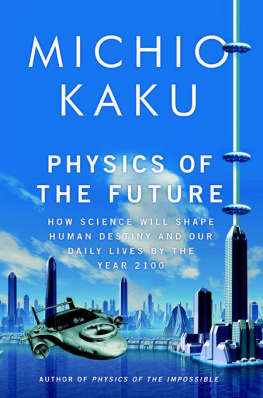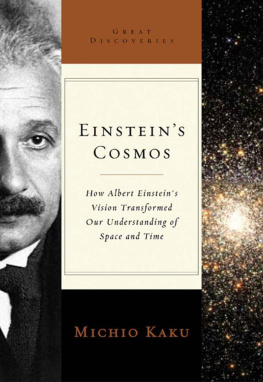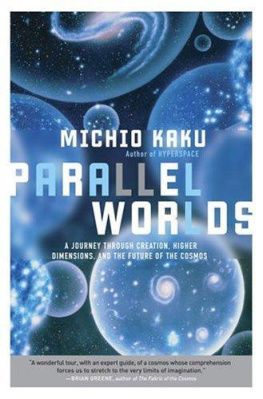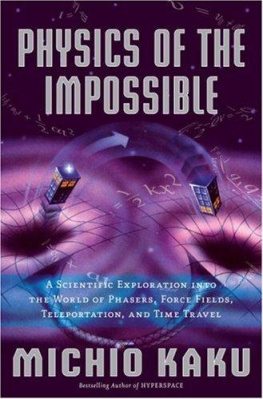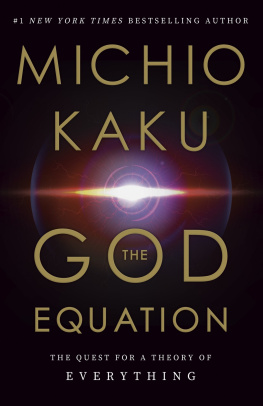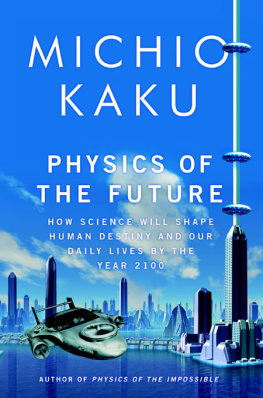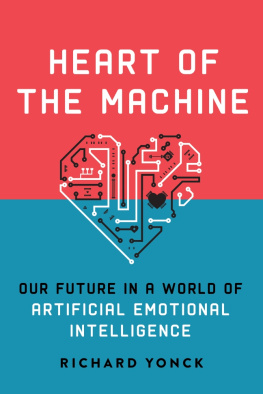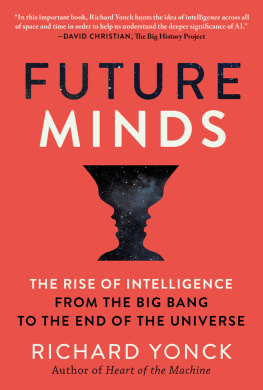

Copyright 2011 by Michio Kaku
All rights reserved. Published in the United States by Doubleday, a division of Random House, Inc., New York, and in Canada by Random House of Canada Limited, Toronto.
www.doubleday.com
DOUBLEDAY and the DD colophon are registered trademarks of Random House, Inc.
constitutes an extension of this copyright page.
LIBRARY OF CONGRESS CATALOGING-IN-PUBLICATION DATA
Kaku, Michio.
Physics of the future : how science will shape human destiny and
our daily lives by the year 2100 / Michio Kaku.1st ed.
p. cm.
Includes bibliographical references.
1. ScienceSocial aspectsForecasting. 2. ScienceHistory21st century. I. Title.
Q175.5.K257 2011
303.4830112dc22
2010026569
eISBN: 978-0-385-53081-1
v3.1
To my loving wife, Shizue, and my daughters, Michelle and Alyson











I would like to thank those individuals who have worked tirelessly to make this book a success. First, I would like to thank my editors, Roger Scholl, who guided so many of my previous books and came up with the idea for a challenging book like this, and also Edward Kastenmeier, who has patiently made countless suggestions and revisions to this book that have greatly strengthened and enhanced its presentation. I would also like to thank Stuart Krichevsky, my agent for so many years, who has always encouraged me to take on newer and more exciting challenges.
And, of course, I would like to thank the more than three hundred scientists I interviewed or had discussions with concerning science. I would like to apologize for dragging a TV camera crew from BBC-TV or the Discovery and Science channels into their laboratories and thrusting a microphone and TV camera in front of their faces. This might have disrupted their research, but I hope that the final product was worth it.
I would like to thank some of these pioneers and trailblazers:
Eric Chivian, Nobel laureate, Center for Health and the Global Environment, Harvard Medical SchoolPeter Doherty, Nobel laureate, St. Jude Childrens Research HospitalGerald Edelman, Nobel laureate, Scripps Research InstituteMurray Gell-Mann, Nobel laureate, Santa Fe Institute and CaltechWalter Gilbert, Nobel laureate, Harvard UniversityDavid Gross, Nobel laureate, Kavli Institute for Theoretical Physicsthe late Henry Kendall, Nobel laureate, MITLeon Lederman, Nobel laureate, Illinois Institute of TechnologyYoichiro Nambu, Nobel laureate, University of ChicagoHenry Pollack, Nobel laureate, University of MichiganJoseph Rotblat, Nobel laureate, St. Bartholomews HospitalSteven Weinberg, Nobel laureate, University of Texas at AustinFrank Wilczek, Nobel laureate, MITAmir Aczel, author of Uranium Wars Buzz Aldrin, former NASA astronaut, second man to walk on the moonGeoff Andersen, research associate, United States Air Force Academy, author of The Telescope Jay Barbree, NBC news correspondent, coauthor of Moon Shot John Barrow, physicist, University of Cambridge, author of Impossibility Marcia Bartusiak, author of Einsteins Unfinished Symphony Jim Bell, professor of astronomy, Cornell UniversityJeffrey Bennet, author of Beyond UFOs Bob Berman, astronomer, author of Secrets of the Night Sky Leslie Biesecker, chief of Genetic Disease Research Branch, National Institutes of HealthPiers Bizony, science writer, author of How to Build Your Own Spaceship Michael Blaese, former National Institutes of Health scientistAlex Boese, founder of Museum of HoaxesNick Bostrom, transhumanist, University of OxfordLt. Col. Robert Bowman, Institute for Space and Security StudiesLawrence Brody, chief of the Genome Technology Branch, National Institutes of HealthRodney Brooks, former director, MIT Artificial Intelligence LaboratoryLester Brown, founder of Earth Policy InstituteMichael Brown, professor of astronomy, CaltechJames Canton, founder of Institute for Global Futures, author of The Extreme Future Arthur Caplan, director, Center for Bioethics, University of PennsylvaniaFritjof Capra, author of The Science of Leonardo Sean Carroll, cosmologist, CaltechAndrew Chaikin, author of A Man on the Moon Leroy Chiao, former NASA astronautGeorge Church, director, Center for Computational Genetics, Harvard Medical SchoolThomas Cochran, physicist, Natural Resources Defense CouncilChristopher Cokinos, science writer, author of The Fallen Sky Francis Collins, director of the National Institutes of HealthVicki Colvin, director of Biological and Environmental Nanotechnology, Rice UniversityNeil Comins, author of The Hazards of Space Travel Steve Cook, director of Space Technologies, Dynetics, former NASA spokespersonChristine Cosgrove, author of Normal at Any Cost Steve Cousins, president and CEO, Willow GarageBrian Cox, physicist, University of Manchester, BBC science hostPhillip Coyle, former assistant secretary of defense, U.S. Defense DepartmentDaniel Crevier, author of AI: The Tumultuous History of the Search for Artificial Intelligence, CEO of CorecoKen Croswell, astronomer, author of Magnificent Universe Steven Cummer, computer science, Duke UniversityMark Cutkosky, mechanical engineering, Stanford UniversityPaul Davies, physicist, author of Superforce Aubrey de Gray, Chief Science Officer, SENS Foundationthe late Michael Dertouzos, former director, Laboratory for Computer Science, MITJared Diamond, Pulitzer Prize winner, professor of geography, UCLAMariette DiChristina, editor in chief, Scientific American Peter Dilworth, former MIT AI Lab scientistJohn Donoghue, creator of BrainGate, Brown UniversityAnn Druyan, widow of Carl Sagan, Cosmos StudiosFreeman Dyson, emeritus professor of physics, Institute for Advanced Study, PrincetonJonathan Ellis, physicist, CERNDaniel Fairbanks, author of Relics of Eden Timothy Ferris, emeritus professor at the University of California, Berkeley, author of Coming of Age in the Milky Way Maria Finitzo, filmmaker, Peabody Award winner, Mapping Stem Cell Research Robert Finkelstein, AI expertChristopher Flavin, WorldWatch InstituteLouis Friedman, cofounder, Planetary SocietyJames Garvin, former NASA chief scientist, NASA Goddard Space Flight CenterEvalyn Gates, author of Einsteins Telescope Jack Geiger, cofounder, Physicians for Social ResponsibilityDavid Gelernter, professor of computer science, Yale UniversityNeil Gershenfeld, director, Center of Bits and Atoms, MITPaul Gilster, author of Centauri Dreams Rebecca Goldburg, former senior scientist at Environmental Defense Fund, director of Marine Science, Pew Charitable TrustDon Goldsmith, astronomer, author of The Runaway Universe Seth Goldstein, professor of computer science, Carnegie Mellon UniversityDavid Goodstein, former assistant provost of Caltech, professor of physicsJ. Richard Gott III, professor of astrophysical sciences, Princeton University, author of Time Travel in Einsteins Universe the late Stephen Jay Gould, biologist, Harvard Lightbridge Corp.Ambassador Thomas Graham, expert on spy satellitesJohn Grant, author of Corrupted Science Eric Green, director of the National Human Genome Research Institute, National Institutes of HealthRonald Green, author of Babies by Design Brian Greene, professor of mathematics and physics, Columbia University, author of The Elegant Universe Alan Guth, professor of physics, MIT, author of The Inflationary Universe William Hanson, author of The Edge of Medicine Leonard Hayflick, professor of anatomy, University of California at San Francisco Medical SchoolDonald Hillebrand, director of Center for Transportation Research, Argonne National LaboratoryFrank von Hipple, physicist, Princeton UniversityJeffrey Hoffman, former NASA astronaut, professor of aeronautics and astronautics, MITDouglas Hofstadter, Pulitzer Prize winner, author of Gdel, Escher, Bach John Horgan, Stevens Institute of Technology, author of The End of Science Jamie Hyneman, host of MythBusters Chris Impey, professor of astronomy, University of Arizona, author of The Living Cosmos Robert Irie, former scientist at AI Lab, MIT, Massachusetts General HospitalP. J. Jacobowitz, PC magazineJay Jaroslav, former scientist at MIT AI LabDonald Johanson, paleoanthropologist, discoverer of LucyGeorge Johnson, science journalist, New York Times Tom Jones, former NASA astronautSteve Kates, astronomer and radio hostJack Kessler, professor of neurology, director of Feinberg Neuroscience Institute, Northwestern UniversityRobert Kirshner, astronomer, Harvard UniversityKris Koenig, filmmaker and astronomerLawrence Krauss, Arizona State University, author of The Physics of Star Trek Robert Lawrence Kuhn, filmmaker and philosopher, PBS TV series Closer to Truth Ray Kurzweil, inventor, author of The Age of Spiritual Machines Robert Lanza, biotechnology, Advanced Cell TechnologyRoger Launius, coauthor of Robots in Space Stan Lee, creator of Marvel Comics and Spider-ManMichael Lemonick, former senior science editor, Time magazine, Climate CentralArthur Lerner-Lam, geologist, volcanist, Columbia UniversitySimon LeVay, author of When Science Goes Wrong John Lewis, astronomer, University of ArizonaAlan Lightman, MIT, author of Einsteins Dreams George Linehan, author of SpaceShipOne Seth Lloyd, MIT, author of Programming the Universe Joseph Lykken, physicist, Fermi National Accelerator LaboratoryPattie Maes, MIT Media LaboratoryRobert Mann, author of Forensic Detective Michael Paul Mason, author of Head Cases W. Patrick McCray, author of Keep Watching the Skies! Glenn McGee, author of The Perfect Baby James McLurkin, former scientist at MIT AI Laboratory, Rice UniversityPaul McMillan, director, Spacewatch, University of ArizonaFulvio Melia, professor of physics and astronomy, University of ArizonaWilliam Meller, author of Evolution Rx Paul Meltzer, National Institutes of HealthMarvin Minsky, MIT, author of The Society of Mind Hans Moravec, research professor at Carnegie Mellon University, author of Robot the late Phillip Morrison, physicist, MITRichard Muller, astrophysicist, University of California at BerkeleyDavid Nahamoo, formerly with IBM Human Language TechnologyChristina Neal, volcanist, Alaska Volcano Observatory, U.S. Geological SurveyMichael Novacek, curator, Fossil Mammals, American Museum of Natural HistoryMichael Oppenheimer, environmentalist, Princeton UniversityDean Ornish, clinical professor of medicine, University of California, San FranciscoPeter Palese, professor of microbiology, Mt. Sinai School of MedicineCharles Pellerin, former NASA officialSidney Perkowitz, professor of physics, Emory University, author of Hollywood Science John Pike, director, GlobalSecurity.org Jena Pincott, author of Do Gentlemen Really Prefer Blondes? Tomaso Poggio, artificial intelligence, MITCorrey Powell, editor in chief, Discover magazineJohn Powell, founder, JP AerospaceRichard Preston, author of The Hot Zone and The Demon in the Freezer Raman Prinja, professor of astrophysics, University College LondonDavid Quammen, science writer, author of The Reluctant Mr. Darwin Katherine Ramsland, forensic scientistLisa Randall, professor of theoretical physics, Harvard University, author of Warped Passages Sir Martin Rees, professor of cosmology and astrophysics, Cambridge University, author of Before the Beginning Jeremy Rifkin, founder, Foundation on Economic TrendsDavid Riquier, director of Corporate Outreach, MIT Media LabJane Rissler, Union of Concerned ScientistsSteven Rosenberg, National Cancer Institute, National Institutes of HealthPaul Saffo, futurist, formerly with Institute for the Future, consulting professor at Stanford Universitythe late Carl Sagan, Cornell University, author of Cosmos Nick Sagan, coauthor of You Call This the Future? Michael Salamon, NASAs Beyond Einstein programAdam Savage, host of MythBusters Peter Schwartz, futurist, cofounder of Global Business Network, author of The Long View Michael Shermer, founder of the Skeptics Society and Skeptic magazineDonna Shirley, former manager, NASA Mars Exploration ProgramSeth Shostak, SETI InstituteNeil Shubin, professor of organismal biology and anatomy, University of Chicago, author of Your Inner Fish Paul Shuch, executive director emeritus, SETI LeaguePeter Singer, author of Wired for War, Brookings InstituteSimon Singh, author of Big Bang Gary Small, coauthor of iBrain Paul Spudis, Planetary Geology Program of the NASA Office of Space Science, Solar System DivisionSteven Squyres, professor of astronomy, Cornell UniversityPaul Steinhardt, professor of physics, Princeton University, coauthor of Endless Universe Gregory Stock, UCLA, author of Redesigning Humans Richard Stone, The Last Great Impact on Earth, Discover MagazineBrian Sullivan, formerly with the Hayden PlanetariumLeonard Susskind, professor of physics, Stanford UniversityDaniel Tammet, autistic savant, author of Born on a Blue Day Geoffrey Taylor, physicist, University of Melbournethe late Ted Taylor, designer of U.S. nuclear warheadsMax Tegmark, physicist, MITAlvin Toffler, author of The Third Wave Patrick Tucker, World Future SocietyAdmiral Stansfield M. Turner, former Director of Central IntelligenceChris Turney, University of Exeter, UK, author of Ice, Mud and Blood Neil deGrasse Tyson, director, Hayden PlanetariumSesh Velamoor, Foundation for the FutureRobert Wallace, coauthor of Spycraft, former director of CIAs Office of Technical ServicesKevin Warwick, human cyborgs, University of Reading, UKFred Watson, astronomer, author of Stargazer the late Mark Weiser, Xerox PARCAlan Weisman, author of The World Without Us Daniel Werthimer, SETI at Home, University of California at BerkeleyMike Wessler, former scientist, MIT AI LabArthur Wiggins, author of The Joy of Physics Anthony Wynshaw-Boris, National Institutes of HealthCarl Zimmer, science writer, author of Evolution Robert Zimmerman, author of Leaving Earth Robert Zubrin, founder, Mars Society
 Next page
Next page
